My dad is from a small town in Massachusetts and has never been much for travel, but his eyes lit up like a child’s when I told him I was headed to Stuttgart, the capital of the German state of Baden-Württemberg in the Swabian region of southwestern Germany. A lifelong car buff, pop knew Stuttgart as the headquarters of Mercedes-Benz and Porsche. Driving me to the airport, he gushed about the legendary car museums in his coarse Boston accent: “Christalmighty, Johnny Boy, you’ll see the most gawgeous Muhcedes and Pawsches evah made!” I could only imagine otherwise-polite Germans shuddering at his pronunciation of their cherished automobile brands (but I kept that to myself).
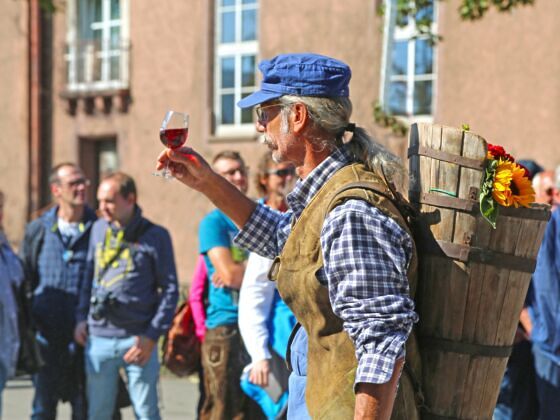

In Stuttgart, Germany, Come for the Wine Festival and Cars, Stay for the History and Culture
More so than cars, my mind dwelled on the upcoming Stuttgarter Weindorf, a raucous, al fresco wine festival held each year from late August to early September. And as a philosophy and literature nerd, I was looking forward to paying homage to Friedrich Schiller and Georg Wilhem Friedrich Hegel, two giants of German letters and sons of Stuttgart.
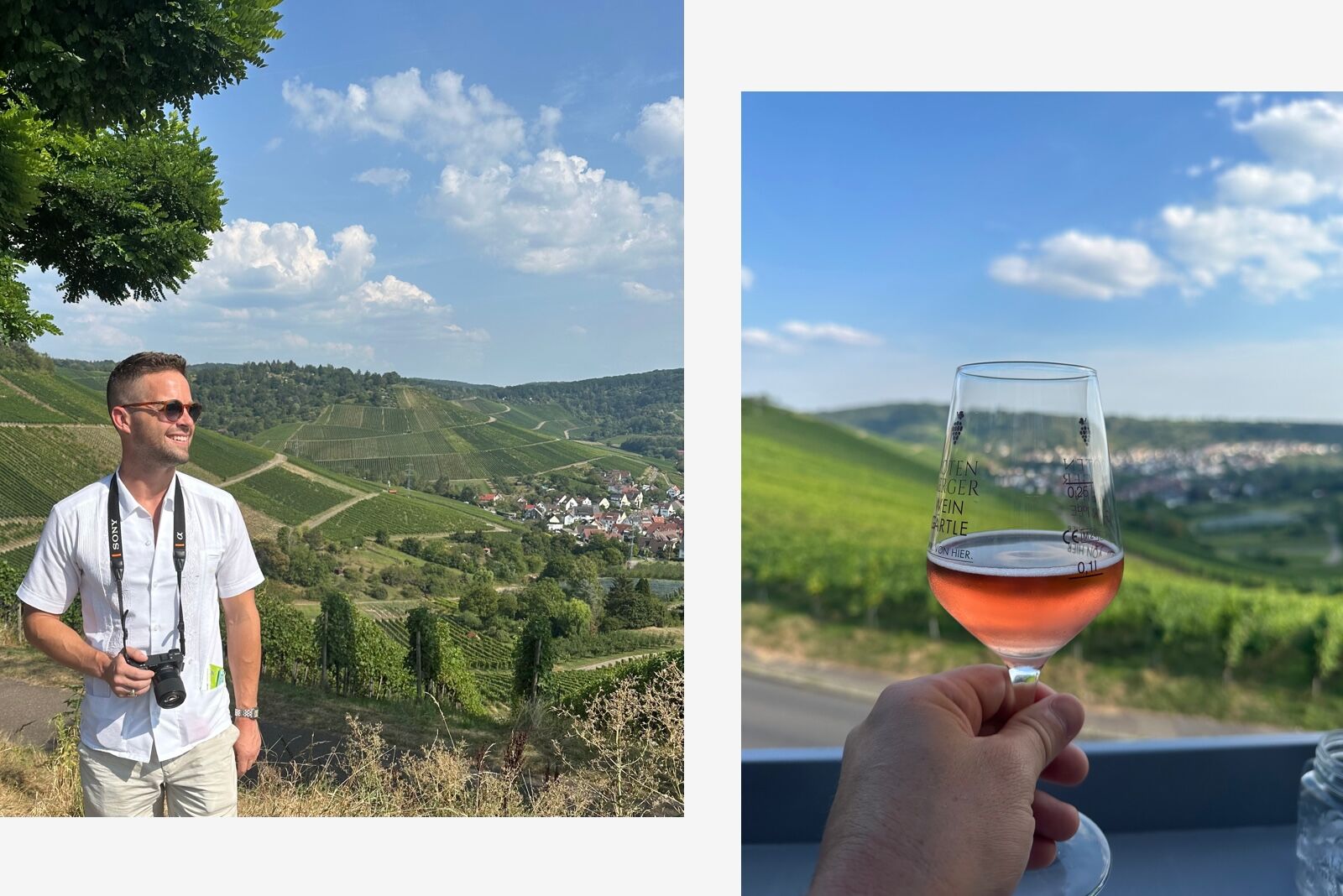
Photo: Johnny Motley
As expected, the Weindorf was a hoot — copious cups of crisp white wines, plates of schnitzel at long wooden tables — but exploring the rest of Stuttgart was just as delightful. It reminded me of a German version of a salt-of-the-earth city in the American Heartland, but with a few extra centuries of history. The automotive industry draws transplants from all over the globe. The rollicking bar culture in neighborhoods like Bohnenviertel and Marienplatz matches the fan fervor for VfB Stuttgart, one of Germany’s storied soccer teams. By the time I departed, Stuttgart was firmly one of my favorite cities to visit in Europe.
The Weindorf is an excellent reason to visit, but Stuttgart’s charms are year-round: the car museums, buzzing biergartens, mountainside vineyards, and wonderfully welcoming atmosphere.
What to do in Stuttgart
The Porsche Museum
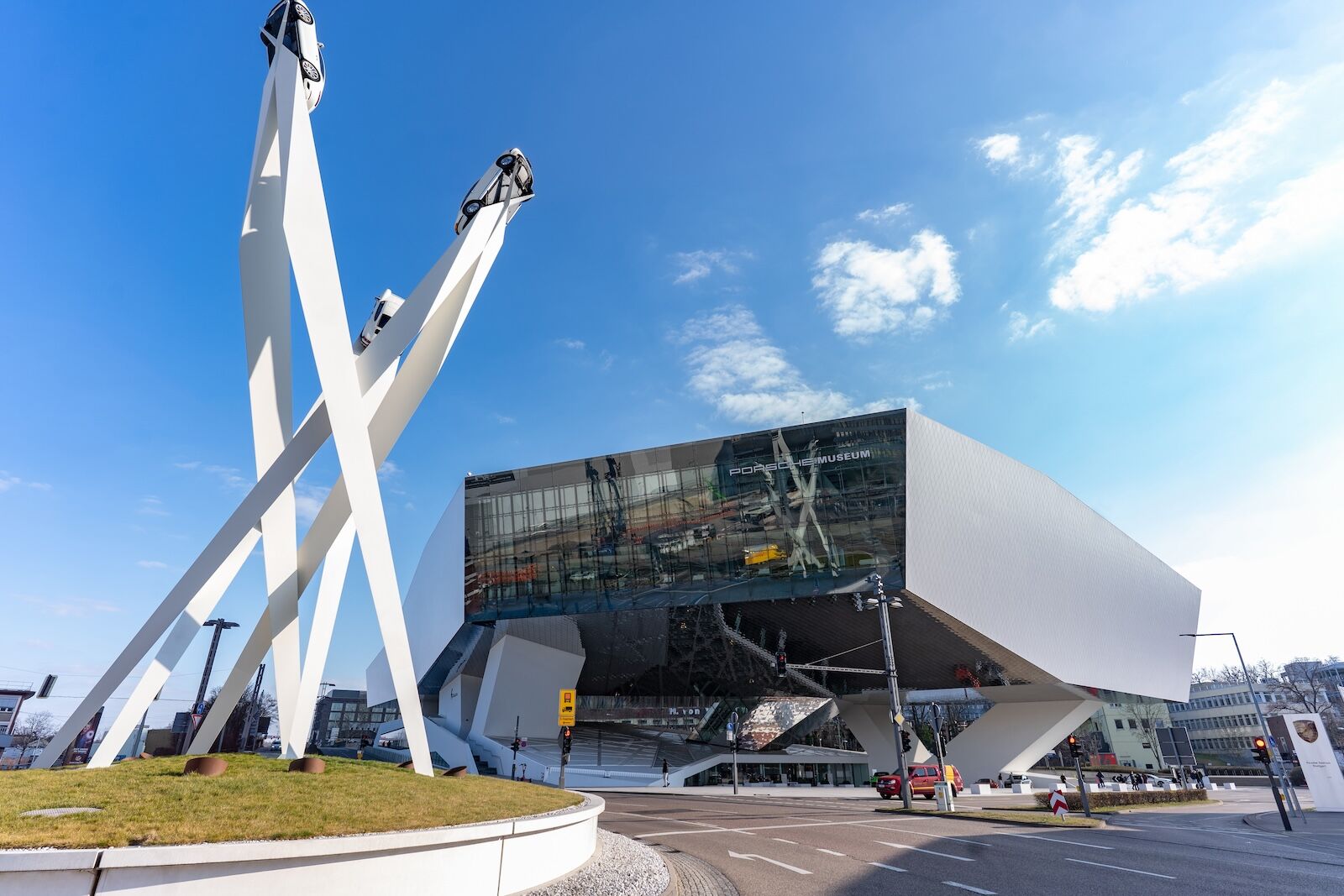
Photo: Porsche Museum / Martina Denker
The Porsche Museum, in the shadow of Porsche’s main factory in the Zuffenhausen neighborhood, is 6-cylinder nirvana for car buffs. Designed by Austrian architectural firm Delugan Meissl, the museum appears to float above the ground when viewed from a distance—avant-garde architecture as sleek as the supercars housed within. The collection spans the full history of the Porsche brand, from early 20th-century motorized carriages to cutting-edge experimental race cars. Plan to spend about an hour exploring the museum and admiring the rocket-like steel chariots. When hunger strikes, stroll down the street to B’n’du, an outdoor currywurst joint favored by automobile factory workers on lunch break.
Porsche Museum: Porscheplatz 1, 70435 Stuttgart, Germany
The Mercedes-Benz Museum

Photo: SMG Werner-Dieterich
Mercedes-Benz is a major employer and part of Stuttgart’s economy, and the Mercedes-Benz Museum is one of the city’s beloved landmarks. The museum houses 160 cars, including a 300 SLR Uhlenhaut Coupé, the most expensive car ever sold at a cool $142 million dollars. Only one other model exists, and it’s in the possession of an undisclosed billionaire. The building’s design, a descending helix similar to the Guggenheim Museum in Manhattan, is as delightful to the eye as a cherry-red vintage SL Coupe. If you need a caffeinated pick-me-up or a pastry to nibble on, make a pitstop at the museum cafe overlooking the race car collection.
Mercedes-Benz Museum: Mercedesstraße 100, 70372 Stuttgart, Germany
Visit the Museum of Viticulture and take a wine tour

Photo: SMG Werner-Dieterich
Sip rare pours of Swabian wine while learning about German viticultural history at The Stuttgart Wine Museum. The museum space is in a former wine press building, and tours take visitors through the history of German and international wine-making with displays of wine-making tools of centuries past. A bar with a large array of Swabian wines graces the entrance, so feel free to savor fragrant vinos as you learn about them from the exhibits. You can also hop on an open-air bus in front of the museum entrance for a boozy tour of Stuttgart’s vineyards. The tour shuttles guests up into the mountains framing Stuttgart, and the views of the city and its trellised hills pair wonderfully with pours of trollinger and lemberger.
Weinbaumuseum Stuttgart: Uhlbacher Pl. 4, 70329 Stuttgart, Germany
Hiking and partying in Marienplatz

Photo: Johnny Motley
Whenever I arrive in a new city, I ask hotel receptionists and local barflies about the best nightlife neighborhoods. The consensus I received in Stuttgart was that Marienplatz, a hip young neighborhood in South Stuttgart, was a mainstay for beer- and schnapps-fueled hijinx. The main plaza in Marienplatz, the area with the train station, is lined with bars, restaurants, and cafes. After dark, the peripheral streets buzz with thirsty revelers well into the wee hours.
Marienplatz is charming during the day as well, especially for exploring the ancient vineyards embedded within Stuttgart’s urban landscape. If you’re up for a hike, walk from the Marienplatz train station to Karlshöhe Biergarten, a sunny watering hole overlooking sloping vineyards. The walk, about 30 minutes, takes you up Stuttgart’s iconic Stäffele, ancient stone staircases criss-crossing the vine-trellised hills. The reward at the end of the trek is a cold draught of Hofbräu Pilsner.
The Stuttgarter Weindorf
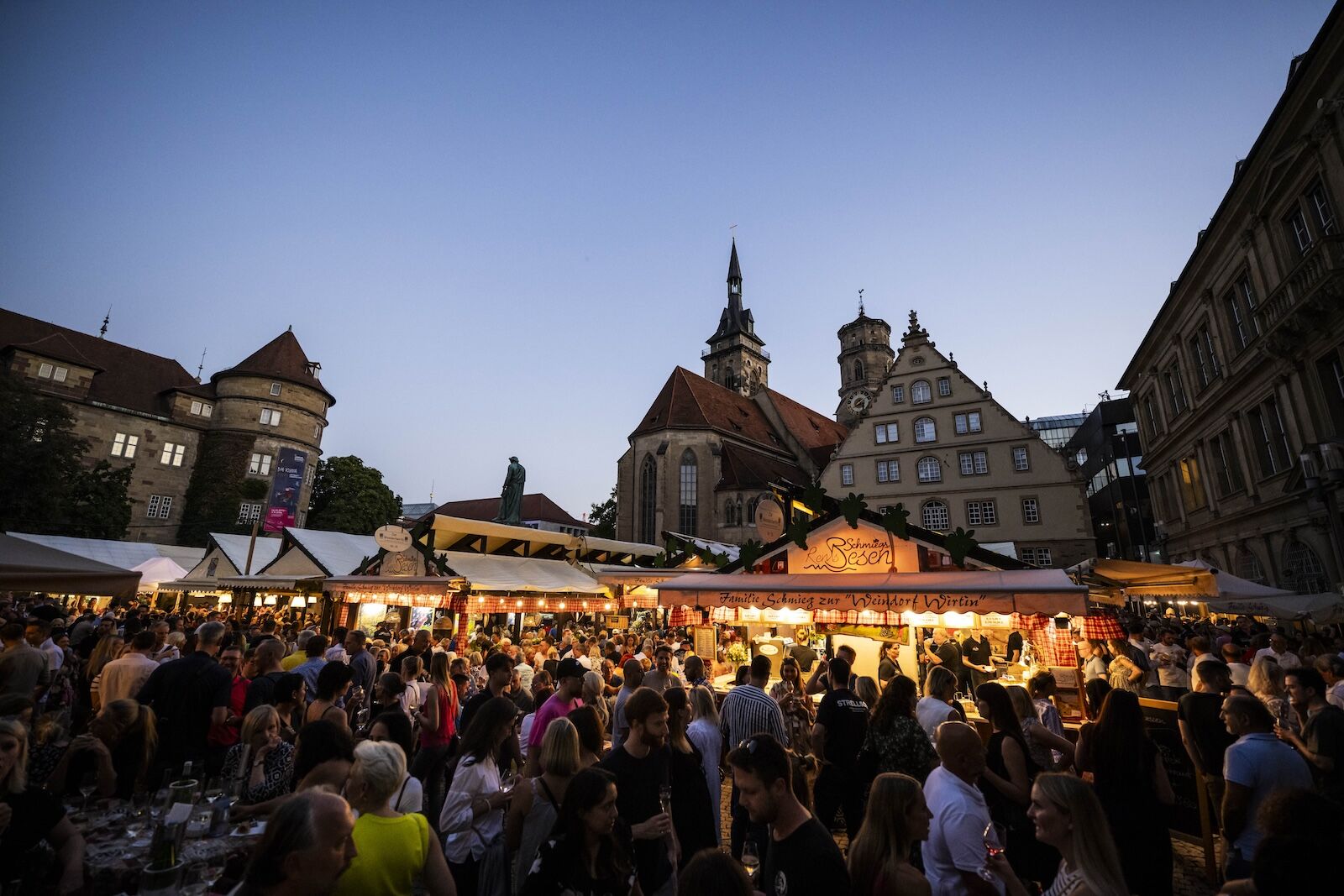
Photo: Pro Stuttgart / Tom Weller
Stuttgarters take to lively public festivals to gather and blow off steam. Cannstatter Wasen, which takes place each fall, is Germany’s largest beer festival after Oktoberfest in Munich. Stuttgart’s Christmas Market, dating back to the 1600s, is a schnapps-soaked winter wonderland complete with concerts, snow sculptures, and enough Christmas lights and tinsel to outshine the sun.
Then, of course, there’s the Stuttgarter Weindorf in the late summer. The wine festival takes place in the Marktplatz neighborhood, an important market quarter in Stuttgart since the Middle Ages. For the festival’s two-week duration, the Marktplatz transforms into a rustic village, with makeshift bars, restaurants, and shops constructed like the wooden cottages of the Swabian countryside. While the Weindorf began in the 1970s, Stuttgart has been a major wine-producing area since it was part of ancient Rome, and it was one of the largest wine-producing areas in the Holy Roman Empire by the 16th century. Vineyards still comprise 2 percent of the city’s footprint. The Weindorf is an excellent venue to learn about Swabian wines, which are primarily made with lemberger, spätburgunder (also called blauburgunder and the local names for pinot noir), and trollinger grapes for reds, and riesling, kerner, silvaner and müller thurgau for whites. Look for the pleasant hints of wet stone, a flavor Germans call bodagfährtle, in sips of trollinger and blauburgunder.
The revelry at the Weindorf starts around sunset and continues well past midnight. The restaurants in the Wine Village, modeled after country inns called besom, serve traditional, hearty Swabian fare. Must-try regional delicacies include maultaschen (a raviolo-like dumpling stuffed with potatoes, chives, and ground meat and covered with gravy) and blutwurst (blood sausage seasoned with spices and thickened with breadcrumbs).
Take a Day Trip to Esslingen
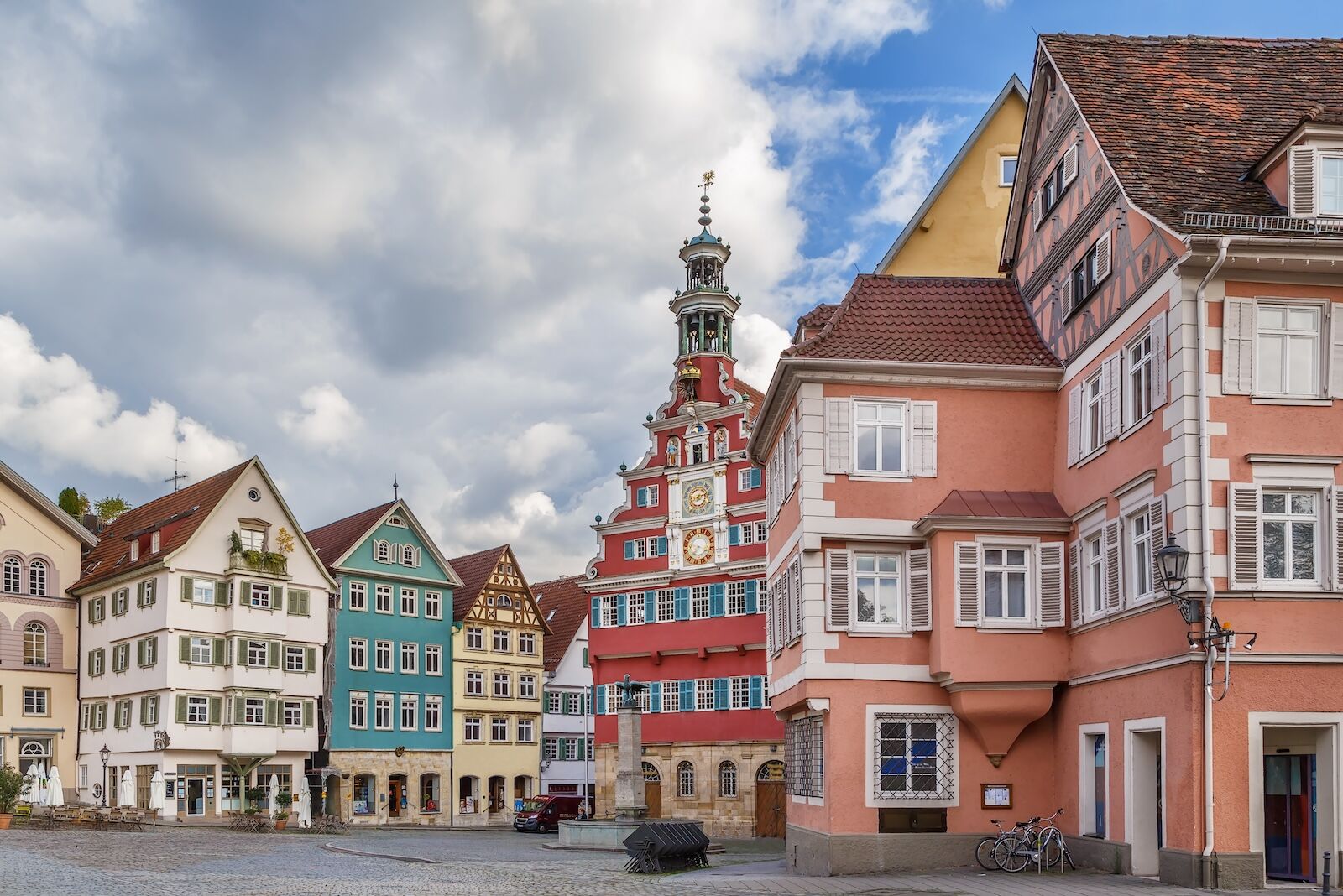
Photo: Borisb17 / Shutterstock
Esslingen am Neckar, 20 minutes by train from Stuttgart, is like a village lifted from the pages of a Brothers Grimm fairy tale: Gothic steeples soar above a stately town square, a castle crowns wine-terraced hills, and centuries-old pubs and shops with façades of fachwerk (exposed timbers alternating with white plaster) line the streets. While a sleepy town today, Esslingen was once one of southern Germany’s most important commercial cities. Esslingen connected the German kingdoms to Flanders via the Neckar River, and the city grew rich from the tolls collected from merchants transporting textiles, wine, and grains across Central Europe.
The pious denizens of Esslingen began construction on St. Dionys Cathedral, one of the oldest churches in southern Germany, in the 8th century. The Gothic-Romanesque masterpiece wasn’t completed until 1213. Marvel at the stained glass and masonry inside, then hike up the trails behind the church for full views of the steeples carved with stone tracery as delicate as paper doilies.
Lace up your boots and hit the trails for Esslingen Castle, a hilltop fortress overlooking the city. The hike is steep, but the view of the vineyard and the village are well worth the sweat. Better yet, there’s a top-notch biergarten, Restaurant Palmscher Bau, right next to the castle. The cold suds and roasted sausages taste even better after the trek. For a non-pareil tour guide in Esslingen, ask for Thomas Hale, an American expat fluent in German, at the Esslingen Visitors Center on the town’s central plaza.
You can explore most of Esslingen in a day. I suggest arriving before lunch and catching the train back to Stuttgart after dinner. Spend the first hours exploring the historical sites and walking trails through the vineyards overlooking the city. Then, as afternoon fades into evening, kick back in an outdoor wine bar or biergarten before strolling back to the train station.
The Markthalle Stuttgart

Photo: Johnny Motley
For a deep dive into Swabian cuisine, spend a morning perusing the Markthalle Stuttgart, a bustling indoor market built in 1914. While bombings destroyed much of Stuttgart during World War II, the Markthalle was one of the few historical buildings not reduced to rubble. It’s a brilliant example of Art Nouveau, a hallmark of Stuttgart’s urban texture.
In addition to Swabian wines, pastries, charcuterie, and farm-fresh produce, you can find international delicacies from Spain, Italy, and Asia in the Markthalle. Most market-goers come to buy their weekly groceries, and the market also houses several buzzy, small restaurants. Visit Markthalle Stuttgart: Dorotheenstraße 4, 70173 Stuttgart, Germany
Where to Stay in Stuttgart
EmiLu Hotel, right around the corner from the Marktplatz, is beautiful, comfortable, and conveniently located. After pulling a double espresso from my in-room machine, I spent an hour each morning working on my computer in the lobby’s sunny alcove. After work, I walked over to the breakfast buffet — a spread of smoked fish, charcuterie, eggs, and muesli. If I wasn’t at the Weindorf filling my snout with wine, I usually grabbed a draught of local Stuttgart beer from EmiLu’s lobby bar before bed.
Rooms are handsome and full of natural light, with windows overlooking the busy streets of Stuttgart’s historic core. If you’re in town for the Weindorf, you’ll only have to stumble home a few blocks before you’re toes up in your comfy bed. Make some time to catch the sunset at EmiLu’s rooftop bar and to tie one on at Tatti’s, a glitzy cocktail bar right next door to the hotel.
EmiLu Hotel: Nadlerstraße 4, 70173 Stuttgart, Germany